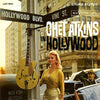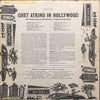



Chet Atkins - In Hollywood
Chet Atkins - guitar [click here to see more vinyl featuring Chet Atkins]
Howard Roberts (g); Jethro Burns (mand); Clifford Hils, George Callender (b); Larry Bunker, Jack Sperling (dr) & strings
Written by Ross Bagdasarian (A1), Gilbert Bécaud (A2), Manny Curtis (A2), Pierre Delanoë (A2), George Duning (A3), Boudleaux Bryant (A4), Manuel Ponce (A5), Richard Maltby, Jr. (A6), Fats Waller (A6), Stanley Adams (B1), Hoagy Carmichael (B1), Charlie Chaplin (B2), Bert Reisfeld (B3), Jean Villard (B3), Don Titman (B4), Eric Spear (B6). B5 is a traditionnal song.
1 LP, standard sleeve
Original analog Master tape : YES
Heavy Press : 180g
Record color : black
Speed : 33 RPM
Size : 12'’
Stereo
Studio
Record Press : Pallas
Label : Speakers Corner
Original Label : RCA
Recording: October 1958 in Hollywood
Production: Chet Atkins
Originally released in 1961
Reissued in 2020
Tracks :
Side A :
1. Armen's Theme
2. Let It Be Me
3. Theme From "Picnic"
4. Theme From A Dream
5. Estrelita
6. Jitterbug Waltz
Side B :
1. Little Old Lady
2. Limelight
3. The Three Bells
4. Santa Lucia
5. Greensleeves
6. Meet Mr. Callaghan
Reviews :
« If the cover of At Home evokes the 1950s, the music on In Hollywood is the 1950s: a warm, cozy, sophisticated album of mood music in the best sense. Yet this is not an album of film music (though a handful of film themes turn up). Rather, it is exactly what the title indicates: Chet Atkins recording an album in a Hollywood studio, as opposed to the familiar haunts of Nashville. Here, he places his often affectingly lovely guitar licks in front of full, lush, sometimes inspired string arrangements by Dennis Farnon. Sometimes, Atkins appears all by himself, caressing "Estrellita" before the strings kick in, and his fingerpicking technique appears on a piquant treatment of "Armen's Theme" (originally a pre-Chipmunks hit for Ross Bagdasarian aka David Seville). Farnon is particularly good when he hooks onto a lush string motif and repeats it seductively on the "Theme from Picnic," or follows Atkins' guitar in a broad, surpassingly lovely treatment of Fats Waller's "Jitterbug Waltz" -- the two most gorgeous tracks on the record. For some, this record might fall under the category of guilty pleasures, but a pleasure it is, one of the great make-out records of its time. » AllMusic Review by Richard S. Ginell
« Chet Atkins was a transcendent country music star. He worked his way up through the traditional country scene as a guitarist. He also played mandolin, fiddle banjo and ukulele. The list of artists he backed was extensive, including Hank Snow, The Carter Family, and Red Foley. Atkins was known for popularizing the Merle Travis guitar technique, using the thumb and two or three finger to pick. As a “hired hand” Atkins was good enough to be inducted into the Grand Old Opry in the 50’s. But Atkins’ musical legacy may have been defined by his work as a producer. Along with Owen Bradley and Bob Ferguson, Chet Atkins helped to define the Nashville sound, reducing fiddle and banjo instrumentation and injecting more dynamic sound mixes. Atkins won 14 Grammys and 9 Country Music Awards. He was inducted into the Rock And Roll Hall Of Fame and The Country Music Hall Of Fame.
Atkins primarily considered himself a guitarist. His instrumental prowess encapsulated many other genres including jazz. Atkins once performed at The Newport Jazz Festival. In 1959, he surprised the country music establishment by recording an album in Hollywood with lush string arrangements. Chet Atkins In Hollywood (which was re-mixed in 1961 by Atkins) showed what a brilliant guitarist could do with a wide variety of compositions. Speakers Corner has re-mastered these sessions to 180-gram vinyl. Side 1 opens with a cover of the most unlikely song (“Armen’s Theme”) by Ross Bagdasarian Sr., later known as David Seville of Alvin And The Chipmunks fame. Atkins embraces the Armenian melodic context with his succinct playing and precise, syncopation. Starting with primal electric guitar, the gossamer strings begin the second verse. Then Atkins lays down some country strumming. “Let It Be Me” (originally written as “Je t’apppartiens” in 1955), enjoyed success in France and then as a smash hit for The Everly Brothers in 1960. It is impossible to clear out the over-the-top sentimental resonance, but Atkins’ echo-infused electric guitar is effective in “voicing” the melody. The strung accompaniment is restrained.
One of the most iconic film score moments is the William Holden/Kim Novak dance scene in Picnic. The dramatic “Picnic “Theme” interlude (within the “Moonglow” tune) is re-purposed by “Mr. Guitar”, focusing solely on the theme song. Atkins succinct phrasing intermingles with the string counterpoint and approximates the sweeping romanticism that is at the core of this song (written by Morris Stoloff). It is forever stunning. A minor hit in 1958, Boudleau Bryant’s “Theme From A Dream” is a master class of graceful picking and updated studio engineering. Atkins’ agility and strength as a guitarist permit him to stand up to an entire string section. There are two up-tempo transitions that are mesmerizing. Atkins reaches out for eclecticism on Manuel Ponce’s “Estrellita”. It is core balladry, but with a lot of finesse and signature runs on guitar. Here, the strings impede the momentum slightly. Fats Waller’s “Jitterbug Waltz” showcases the visceral connection between jazz and country, in the hands of an accomplished musician. The string arrangements emphasize both harmony and counterpoint. Atkins approach is understated, but with great rhythmic complexity.
Side 2 has interesting material from many diverse songwriters. Atkins executes a faithful rendition of Hoagy Carmichael’s “Little Old Lady”. The short intro and the trademark loping rhythm is a natural fit. The strings dress it up, similar to the Ray Noble Orchestra 1936 original. The catchy melody line and Americana roots are infectious. Atkins’ guitar bravado is polyrhythmic. Another inspired cover is Charlie Chaplin’s “Limelight”. Here the string augmentation works extremely well. The haunting melody is captured on guitar with a touch of Spanish flair and cinematic aesthetics. “The Three Bells” (a.k.a. “Little Jimmy Brown”) is another unusual selection. There have been so many covers (Floyd Cramer, The Andrew sisters, Andy Williams, The Browns, Elvis Presley, Dolly Parton, Perry Como among many others), that an instrumental seems like a breath of fresh air. Great musicians can take familiar tunes and turn them into personal statements. Atkins accomplishes this on both “Santa Lucia” and “Greensleeves”. His nimble fingering techniques and modern studio production are game changers. There is no better finale than “Meet Mr. Callaghan”. Recorded by Atkins’ (and everyone else’s) favorite guitarist Les Paul in 1952, Chet somehow combines an Irish jig with a country twang. In his inimitable style he infuses the chorus with jazzy notation.
Chet Atkins In Hollywood still has considerable artistic integrity. The audacity of combining the premier country guitarist with strings in Hollywood was a big gamble. It excels because of the phenomenal setlist and its instrumental brilliance. Also, the actual sound mix was progressive in 1961 and with the superior re-mastering at Speakers Corner is even better. The balance with the strings and Atkins is delicate and vibrant. The guitar echo and fade effects sound like a contemporary recording, not something from 1959 or 1961. The “very 60’s” Hollywood And Vine album cover with the “James Bondish” blonde and the electric guitar on the signpost is historical. The original liner notes include RCA Victor’s Living Stereo information and notes on 317X antistatic ingredient are glimpses into the legacy of analog recording. » Robbie Gerson, Audiophile Audition, Jun 28, 2018
When stringed instruments are employed, it is often an indication that the protagonist is somewhat mature. It is an unwritten law that sooner or later every rock, jazz or folk musician will bathe in soft tones for once. Chet Atkins, however, was light years away from his artistic zenith, came up with a wealth of ideas and was in a great position with regards to recording facilities when he set down his Hollywood album in 1959. Two years earlier, “Mister Guitar” had become boss of the newly founded RCA Studio in Nashville. Here he recorded several records, which reflected his ideas of an appealing, catchy Nashville Sound as an answer to the declining rock and roll.
The Hollywood numbers were by no means dynamite movie tracks or showstoppers. Dennis Farnon’s delicate, lush arrangements rather more pay homage to the maestro with his no-frills art of playing. The gentle Italo evergreen "Santa Lucia", Chaplin’s beautiful "Limelight" with its violins and the time-honoured "Greensleeves" – all of them flawlessly performed – are a real pleasure for the ears. Atkins greatly admired the superb string orchestra and two years later he re-recorded the album using the tapes from the Hollywood session to create this new version.
Ratings :
Allmusic : 4.5 / 5 , Discogs : Rate Your Music :



